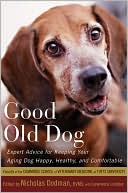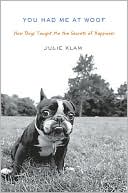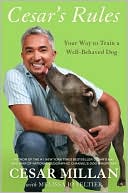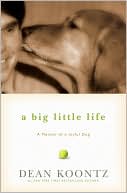How to Raise a Puppy You Can Live With
- 8 catagory development analysis test\ - keys to housebreaking without a hitch\ - common puppy personality types and how to deal with them\ - gentle, effective methods of discipline\ -\ One of the most widely recommended books for puppy buyers. Breeders also treasure the valuable information on canine development during the first seven weeks of life.
Search in google:
- 8 catagory development analysis test- keys to housebreaking without a hitch- common puppy personality types and how to deal with them- gentle, effective methods of discipline-One of the most widely recommended books for puppy buyers. Breeders also treasure the valuable information on canine development during the first seven weeks of life. Veterinary Practice The book makes it crystal clear how to communicate with the puppy, what kinds of things to do when training, and how to give verbal commands.
Ch. 4 THE BREEDER'S RESPONSIBILITY\ Being a breeder of puppies is an important job-one that should be undertaken with a commitment for the time and effort necessary to get the pups off to the best possible start. Aside from a clean, warm box area and good diet, a young puppy has definite behavioral needs. The breeder is the person who supplies these needs. During the first seven weeks, a puppy's three most important needs are exposure to mild stress, a stimulating environment, and individual attention.\ EXPOSURE TO MILD STRESS\ Even though the bitch is the primary influence in the puppy's life for the first twenty-one days, the breeder can at this time begin to influence a puppy's future behavior. Although the pup's eyes don't open until the end of the second week and his hearing isn't functioning until the third week, he will respond on a purely physical level to being touched. Touching and lifting the pup begins to condition his physiology to react, at a very low level, to changes in his experience.\ The First Two Weeks\ Breeders who have made a practice of handling pups at a very young age have observed that these pups become very outgoing and confident as they get older. A study by Dr. Michael Fox verifies and expands this observation. After conducting a study on the heart rates of puppies, he concluded that mildly stressing puppies will develop dogs that are superior when put in learning or competitive situations. Puppies that are handled at an early age and exposed to mild stress on a physiological level are better able to handle stress later in their lives without becoming emotionally disturbed or indulging in hyperactive behavior. As a result, they learn quickly and are more responsive to new experiences in different environments.\ Dr. Carmen Battaglia, in his article "Developing High Achievers," tells of a method developed by the U.S. military to improve the performance of dogs used for military service. It is termed the BioSensor Method, known to the public as the Super Dog Program. Based on research, the military studies confirmed that there are specific periods of time when neurological stimulation has important effects. The first period is a window of time between three days and sixteen days during which there is rapid neurological development. Simple exercises at this time affect the neurological system by pushing it into action earlier than would happen normally, resulting in an increased capacity for future learning. Benefits include improved cardiovascular performance, greater resistance to stress, and greater resistance to disease.\ You can simulate these exercises with your own puppies. Pick up each puppy every day. Rub his softness against your cheek, and admire his miniature perfection-these are the fringe benefits. Hold him for about a minute, with the puppy's body firmly supported by your hand under his tummy. Weigh him if you desire. Using both hands, hold the puppy in an upright position, then in a head-down position, and finally on his back, cradled in your hand. Touch a foot.\ Don't pick up the puppies any more during the day, unless necessary of course. Children should not hold puppies at this age. Too much stress has a negative effect on the puppies' development.\ Weeks Three to Seven\ During these weeks, activities involve the senses and are stressful in the sense that these are new stimulations to the puppies. In the third week, pick the puppy up and use your thumb and finger to put light pressure on the ear or the foot. If he squeaks, he should calm quickly. For these pups, repeat by touching, with no pressure at all, and progress to a slight pressure the next day.\ The fourth week, twenty-two to twenty-eight days, is a very stimulating one for the puppy. He is aware of the many sights and sounds around him and is quite excitable. About midway during the week, take the pup away from his littermates and put him on a different floor surface than he has experienced before. As well as being a stress activity for the puppy, this is also valuable for observation of the pup's behavior and doesn't take more than three to four minutes per puppy.\ Put the puppy down on cement, wood, dirt, or fine gravel, or linoleum if it isn't too slick for walking. If the area is bare, place a jacket on the floor, or place a chair or anything that represents a different object for the pup to either approach or ignore. After you have put the pup down on the floor, begin to record how he reacts to being alone, how quickly he begins to cry, whether he walks around or stays in one place, or if he investigates with his tail wagging.\ You can already begin to see differences in personality in the litter, and it is interesting to keep a record of these. Make a note of which pups are the most aggressive feeders and which ones lose out in competition and always seem to end up on the outside of the puppy pile. Which pups are the noisiest? Which ones squirm and cry when picked up, and which ones settle down and enjoy it?\ The most extreme behaviors stand out first, of course, but don't forget to notice the pups that are in the middle range of temperament. These are the pups that likely will be easily trained as they grow older. Infrequently, it can happen that a pup will show signs of brain damage, such as being able to move only in a tight circle. If you observe unusual behavior, consult your veterinarian about the severity of your particular case.\ If the litter is large and the same color, a dot of fingernail polish in different areas on the puppies or a collar of different-colored rickrack tape helps to identify them as individuals.\ During the fifth and sixth weeks, give the pups mild auditory and visual stress. On one day during each week, play a radio for a few minutes near the puppies when the pups are awake. Play it at a loud but not blaring level. If you have normal hearing and it sounds loud but not irritating to you, it will be sufficient. On another day, give the puppies mild visual stress by flicking the room lights (not in bright daylight) for two or three minutes.\ By the fifth week, individual attention by the breeder will become one of the mild stress activities because a small level of stress exists each time the puppy is removed from his littermates and taken to a different area where you are the main focus of his attention. Many pups show no evidence of stress; others will be hesitant but will become more confident with each experience.\ Individual Attention\ The interaction of the puppies with the bitch and with littermates is profoundly important for at least the first five weeks. If you want a puppy that is well adjusted to his identity as a canid, then his relationships with other dogs are very important. For example, the puppy learns from his littermates and his mother just how much of a bite is too much. He learns through this experience that he must control the use of his jaws.\ As the pup approaches the age of five weeks, the period of curiosity, he begins to explore and will leave his mother and his littermates at times. Among wild canids, other adult members of the pack would interact with the pup, but with the domestic dog, this is the point at which people begin to take over the role of the canine mother, virtually reliving history and in so doing reinforcing the domestication of the puppy into the human world.\ Time spent alone with each puppy helps him learn that the name of the game is to be with people and to pay attention to people. Personal attention helps the puppy develop a feeling of his importance as an individual. This in turn helps him grow into a happy dog eager to please his owner. One-on-one time with a puppy opens the second window of limited opportunity-socialization. This period of time is between the fourth and sixteenth weeks of age. Lack of socialization during these weeks inhibits social and psychological development.\ By the fifth week, twenty-nine to thirty-five days, the central nervous system has developed substantially, and the puppies now have sight, hearing, and smell (or scent) and are beginning to develop distance perception. However, even though the pups need the stimulation of people, sights, and sounds, emotionally they are still very immature and they tire easily; therefore, a little attention goes a long way. At least once during this week, but preferably twice, each puppy should be taken away from the puppy-pen area for at least five minutes. The time can be spent with informal play. Bend down so that your face is close to him, allowing you to interact on your puppy's level. Eye contact and facial expression offer a more intimate interaction.\ This is a good age for new people and children to play with the puppies, provided caution is taken to see that the pups aren't overstimulated. In fact, if there are no children in the home, invite children to visit the puppies.\ During the sixth week, thirty-six to forty-two days, it would be very unfortunate if the breeder neglected to see that each pup got individual attention. People who visit the puppies can help. In the fifth week, the pups probably weren't too interested in a person, but now, at six weeks, most pups will run toward a person and try to climb into a lap or jump on legs. A two-way communication system is developing.\ During the session, call the puppy to you from three to five feet away (on your knees and patting the floor or ground). Walk closely in front of him, and coax him to follow by patting your leg. Sit down on his level for some gentle play. Stroke the pup. Talk to the pup; with your voice, try to get him to look at you.\ Occasionally, there's a puppy in a litter that acts shy and is uncomfortable when taken to a different room or area. He may not want to come to you or may not even want to walk around and investigate the area by himself. When working with this puppy during his individual session, be sure that you are where the pup can neither see nor hear his littermates. Sit down on the floor or ground near him. Don't lean over him-that will only make him more fearful. Talk to him in a quiet voice. Pat your hand on the floor in front of him. Try to get his attention. See if you can coax him to come to you even if it's just a matter of his moving a few inches. This pup needs much gentleness. If you're an impatient person, don't try anything that will make you irritated if the pup doesn't respond the way you think he should. Just spend the time sitting close to the puppy. If neither of you moves for the first session or two, that's the way it is. The puppy will gradually become accustomed to your presence and will begin to approach you and investigate. He should be placed with a person or a family that understands that this puppy will require special attention to develop into a socially functioning puppy, and that he will always remain very sensitive to his environment.\ Environmental Enrichment\ Beginning with the third week, the puppy is busy learning to use his rapidly developing senses. We know from behavioral and physiological studies how rapidly the pup's nervous system is growing, and if the senses aren't stimulated, they won't develop into the pathways that give the pup his best learning potential.\ You don't need to dazzle the puppies with a clutter of items. Do your pups play in the backyard? Lawn furniture is an example of environmental stimulation. Moving the wheelbarrow around for cleanup is another example. This is what we mean when we say that a litter raised in a family home environment is automatically socialized and stimulated. However, when pups are raised in a pen or kennel, specific items need to be added.\ Use whatever is available to you. For example, set a couple of old wood stumps in the pen area. Cardboard boxes are marvelous and fall in the easy-come, easy-go category. These can be dens for a pup to go into or tunnels to walk through. An item that's very popular with one breeder's pups is a wood box about four feet...\
AcknowledgmentsIntroduction 1- Choosing Your Puppy selecting based on breed characteristics * choosing the right puppy 2- Environment shapes behavior * the breeder s role is foremost 3- The First Three Months the developmental periods * the neonatal period * the transitional period * the socialization period 4- The Breeder s Responsibility exposure to mild stress * environmental enrichment 5- Puppy Goes to a New Home preparations * age of the puppy * the first day * first night alone * first visit to a veterinarian * house-training * using crates and kennels * the importance of play * puppies and older dogs 6- Socialization Continues prepare your eight- to sixteen-week-old puppy for the future * stimulate those neurons * teach eye contact * socialize your puppy * introduce the puppy to pretraining activities * important basics when teaching puppies 7- Domesticating Your Puppy shaping behavior * the bonding process * discipline * evaluating the different disciplines * puppies will be puppies 8- Development from Three to Six Months dominance and submission * the avoidance period * teething * the leadership concept * the pack structure * the family pack * conclusion 9- The Importance of Personality individual characteristics * the trainer s personality 10- Dog Signals Using Body Language calming signals * using calming signals * warning signals * conclusion 11- Behavioral Problems why is my puppy acting this way? * guarding the food dish * jumping out of reach * separation distress * digging * chewing * barking * jumping up * mouthiness and biting * the aggressive puppy * find creative solutions 12- The Rewards of Puppy Training communicating with your puppy * teaching your puppy to learn * teaching basic tasks * clicker training * then versus now 13- The Second Six Months more exercise, less freedom * use the basic commands to control behavior * behavioral traits * communication * sexual maturity * the Canine Good Citizen Test * don t worry—have fun! AfterwordAppendix—Puppy Temperament TestingBibliographyAbout the AuthorsIndex
\ Bloodlines"...this informative book has become a standard item included in many new puppy packets supplied by dog breeders. Consider it required reading"\ \ \ \ \ Dog Fancy...as important for puppies as preschool is for children.\ \ \ Fran Ennis"...absolutely indispensable to everyone having anything to so with puppies: breeders, owners, trainers, instructors...totally positive approach...a fantastic book about puppy rearing." \ —Off-Lead\ \ \ \ \ Veterinary PracticeThe book makes it crystal clear how to communicate with the puppy, what kinds of things to do when training, and how to give verbal commands.\ \ \ \ \ Library JournalThe 1981 edition (now out of print) of this little classic on puppy rearing was a word-of-mouth best seller. This substantially revised and expanded edition benefits from an additional decade of observation of puppy behavior by its authors and includes effective, up-to-date methods for educating puppies to become good canine citizens. Along with Job Michael Evans's The Evans Guide for Housetraining Your Dog (Howell, 1987), this is required reading for new puppy owners. Whether the copy still in circulation is battered and gnawed or the book slipped by the first time around, every public library should acquire this new edition, and academic libraries should seriously consider it for its insights into canine behavior. Highly recommended.-- Jennifer King, Monmouth Cty. Lib., Manalapan, N.J.\ \








